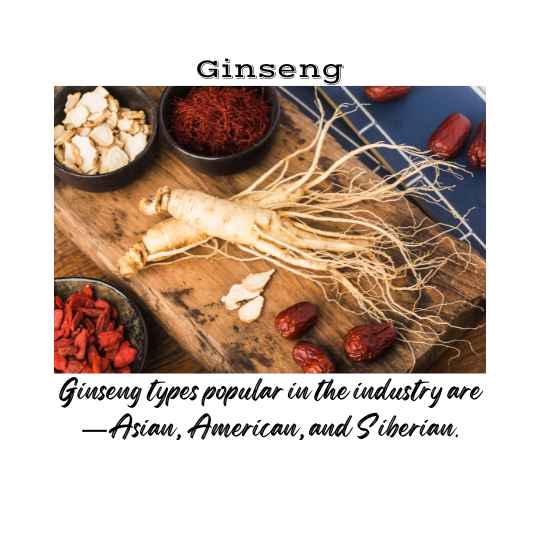Ginseng types popular in the industry are —Asian, American, and Siberian. Ginseng comes from the fleshy roots of perennial slow-growing plants belonging to 11 different species and two different genera.
The most popular ginseng type is – Asian or Korean ginseng. It is the oldest and best-known ginseng. The most famous and commonly found ginseng comes from Panax ginseng. American ginseng comes from Panax quinquefolius. Siberian ginseng is from a different genus: Eleutherococcus senticosus.
American ginseng is indigenous to North America. It is found growing across deciduous forest regions of the Eastern US. Farmers started cultivating the herb in the 1970s. Marathon County in Wisconsin produces over 90% of ginseng grown in the country. It is also widely grown in the Ontario province of Canada. The root collection from the wild is permitted in the US once the plant attains five years or more.
Outside of this family, other ginseng types that are still called ginseng are Malaysian ginseng (Eurycoma longifolia), Peruvian ginseng (Lepidium meyenii), Southern ginseng (Gynostemma pentaphyllum), Brazilian ginseng (Pfaffia paniculata), Kerala ginseng (Trichopus zeylanicus), Thai ginseng (Kaempferia parviflora), Nam ginseng (Dracena angustifolia), and Ashwangandha or Indian ginseng (Withania somnifera). A cheap substitute for Panax ginseng comes from Codonopsis pilosula.
There are 3,944 prescriptions having ginseng as an ingredient in the Korean Clinical Pharmacopeia that has been in place since 1610 AD. Ginseng’s name comes from the Chinese word renshen, translated as “man root.”
Panax ginseng, the most proliferated ginseng type, is cultivated in the Manchurian mountain region of China, where it was discovered over 5,000 years ago. Ginseng was probably used as food until it became known for its strength-giving and rejuvenating properties.
The benefits of ginseng were first documented at the time of the Liang Dynasty (502-557 AD). Ginseng is an ingredient in an entire spectrum of traditional Chinese herbal medicines. It is also used in soaps, lotions, and creams.
The herb was popular with Chinese emperors, who paid for it in gold. Overexploitation led to the near disappearance of the plant. On the back of this, an ancient trade in ginseng with Korea began in the 3rd century AD. The Silk Road was a popular route for this trade between China and the rest of the trading world.
In America, Native American tribes like the Iroquois, Menomonee, Cherokee, and Creeks all valued the herb for its curative powers. Still, ginseng cultivation in the US began in the 20th century. Widespread cultivation has helped save the species from imminent extinction. This ginseng type is different from Korean or Chinese ginseng, which belongs to a different species.
The four largest producers of ginseng are China, South Korea, Canada, and the US. These together make for 99% of global production or 80,080 metric tons. (Baeg et al., 2013). The Chinese production is 44,749 metric tons; South Korea produced 27,480 tons; Canada produced 6,486 tons, and the US 1,054 tons (Korea Ministry for Food, Agriculture, Forestry and Fisheries, Ginseng statistic data, 2010).
China is the largest producer of ginseng. Both China and Korea are also the largest consumers of the herb. The primary use in these countries is as a nutrition supplement. Korea and Canada both export extensively to the US too. Ginseng is said to be consumed in 35 countries worldwide (Baeg et al., 2013).
American ginseng is indigenous to North America. It is found growing across deciduous forest regions of the Eastern US. Farmers started cultivating the herb in the 1970s. Marathon County in Wisconsin produces over 90% of ginseng grown in the country. It is also widely grown in the Ontario province of Canada. Collection of the root from the wild is permitted in the US once the plant attains five years of age or more.
Cultivation of ginseng is done by dibbling the seed in the ground. The plant grows to one to two feet in four to five years. The rhizome, the commercial part of the plant, develops in –four to five years. In the first three years, the roots reach a size of three to eight inches and a weight of one ounce.
The active ingredient ginsenosides are common to the ginseng of the Panax genus. Ginsenosides are a group of steroidal saponins, and over 100 ginsenosides have been identified with similar molecular structures and are bioactive compounds.
Traditionally, ginseng is regarded as both a physical and mental restorant. It improves patients’ cognitive ability, quality of life, and behavior. Ginsenoides and other constituents in ginseng possess immunosuppressive properties.
And there is much more on this group of plants, their botany, uses, and scientific evidence in support or against traditional medicinal use.
